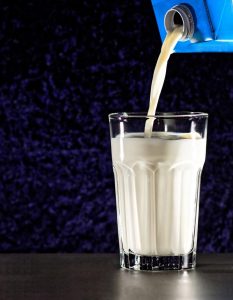
THE amount of polluting phosphorus produced by farms in Northern Ireland is still more than double a sustainable level, farmers have been warned.
Figures obtained from the Department of Agriculture, the Environment and Rural Affairs (Daera) show that farms produced around 10.8kg of excess phosphorus per hectare last year.
Although plants need phosphorus to grow, when too much of the mineral is produced – generally in animal manure – it runs off fields into rivers and lakes and contributes to the growth of harmful algae, as seen in Lough Neagh, Lough Erne, the River Bann and other waterways over the summer.
Phosphorus levels have dropped since 2017, when 12.3kg of the excess mineral was recorded per hectare.
But levels are still more than 24% higher than the 8.7kg recorded per hectare in 2008.
And a government scientist has warned that the current figure of 10.8kg remains more than double the sustainable level.
Brian Ervine, head of environmental farming at Daera, told farmers at an agricultural conference in Belfast earlier this month that “around 5kg (per hectare) is a more sustainable position for agricultural systems”.
Mr Ervine said the use of concentrated feed – processed food which can include a mixture of soy, barley, wheat, maize, molasses and other ingredients – has led to more excess phosphorus in our soil.
“The phosphorus surplus of NI (Northern Ireland) agriculture has gone up because the industry has intensified by importing more concentrate feed,” he said.
Concentrated feed is given to cattle, pigs and poultry to supplement their diets.
Since 2009, there has been a 30% increase in the use of concentrated feed in Northern Ireland.
Soy issues
Soy, a key component of concentrated feed, has been highlighted as contributing to phosphorus pollution.
Soy – a legume native to east Asia but grown in large quantities across South America – has increasingly been used by farmers in the north over the last three decades to help feed their animals.
Between 2009 and 2022, the amount of soy used in feed production in Northern Ireland increased by almost 25%, from 282,900 tonnes to 352,000 tonnes.
Soy is naturally high in phosphorus which means use of the feed is causing more of the mineral to run off into our lakes and rivers.
One dairy farmer told The Detail that the industry turned to soy after cheaper feed ingredients became less viable several decades ago.
The farmer from Limavady, Co Derry, who wished to remain anonymous, said that dairy farmers had become increasingly reliant on soy since the Bovine spongiform encephalopathy (BSE), or ‘mad cow disease’, scandal of the 1980s and early 1990s.
He said after cheaper types of feed were banned, following BSE, dairy farmers turned to soy because it increased milk yields.
“With mad cow disease, meat and bonemeal was banned,” he said.
“So you were left with fishmeal – which, if you use too much of it, can taint the milk – and soya.
“They (farmers) started realising you could feed more soya, increase the rations (daily feed mixture) up to 20%, and your cows would milk brilliantly. It would increase the yields.”
The farmer added that soy-based feed also “masked” problems with other feed types during challenging years.
“If the silage wasn’t good quality, you could increase the protein concentration up to 20% (through adding soy) and the cows’ yields wouldn’t decrease – even if you had a wet year and your silage was bad,” he said.
“So it masked the problem of poor quality fodder and people got addicted to it. We basically got addicted to high-protein rations, including rations using soy.”
Environmental impact of soy
Soy farming itself has been linked to large-scale deforestation in Brazil.
In the last three decades alone, more than 20 million hectares of forest, including in the Amazon, have been cleared for soy production.
William Taylor, from farm collective Farmers for Action, said the environmental footprint of imported soy from South America should rule it out as a feed ingredient for the north’s farmers, who “are on the frontlines” of climate change.
“In these times of accelerated climate change, where farmers are on the frontlines, battling with the weather to grow crops, we should not be having South American grains hauled across half of the world for animal feed here,” he said.
“We should not be burning fossil fuels in this way, unnecessarily. This should not be happening.”
He said farmers and grain producers need to become less reliant on soy.
“If Northern Ireland’s grain mills were to buy all the UK home-grown grains and protein crops that are available across these islands, it would leave us being a lot more self-sufficient and less reliant on South American soya and its disastrous carbon footprint,” he said.
Soy substitutes
In 2021, Daera launched a pilot scheme to encourage the growth of more protein-rich crops which could be used as substitutes for soy-based animal feed.
The scheme, which has been extended to 2026, has seen the number of hectares used to grow protein-rich crops increase from 153 ha (hectares) in 2020 to 784 ha this year.
A Daera spokesman said more than 100 farms have so far taken part in the scheme.
“Since the commencement of the pilot scheme, the area of protein crops grown has increased to 784 ha across 126 farms, with spring beans being the most popular crop,” he said.
“The extended pilot scheme will run for the 2024 – 2026 scheme years, with the aim of assessing the environmental and sustainability benefits which protein crops can deliver.
“The maximum supported area will increase from 1,000ha to 1,300ha to allow for continued evolution of the market and supply chains.”
But, according to part-time dairy farmer and retired aquatic systems researcher, Dr John Spence, one of the main challenges facing the development of a home-grown feed supply is the lack of available land in Northern Ireland.
He told The Detail that the number of livestock farmed in the north would have to be cut to make the agricultural industry more sustainable.
“Those alternative sources of protein are well-known and, in some cases, they are already being used in animal and aquaculture feeds quite widely,” he said.
“But that doesn’t address the total volumes. We couldn’t produce enough peas to substitute for the vast quantities of soy coming in each year. It’s totally impossible.
“All you’re doing, through this unsustainable intensive agriculture model, is exporting the problem and imposing an environmental cost on others – whether that’s in South America or here.
“In Northern Ireland, the environmental cost of all these kinds of concentrate feed is the aquatic environment. It’s not just Lough Neagh alone – it’s every water body in Northern Ireland.”





















